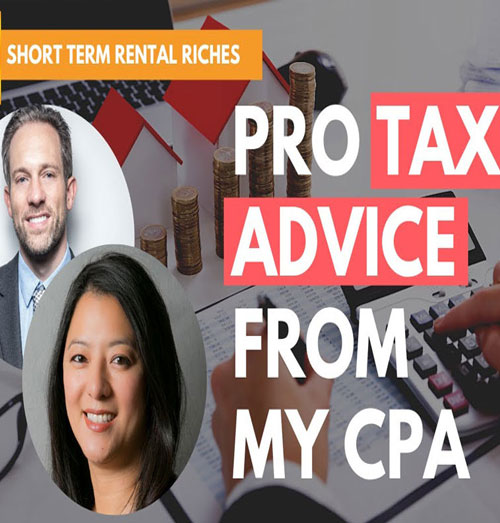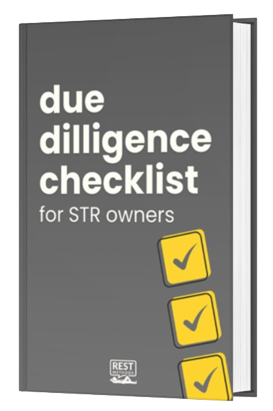Why Real Estate Investors Fail: Avoid these 5 common mistakes in real estate & short-term rentals. Learn key STR success tips to maximize your ROI!
Why do so many real estate investors fail? This is a question I get asked a lot, and it’s something I’ve seen firsthand over the years. Real estate investing can be one of the best ways to build wealth, but it’s not without its challenges. Whether you’re diving into short-term rentals (STRs) or managing long-term properties, avoiding common real estate investing mistakes is crucial if you want to succeed. The truth is, many of the failures investors experience come down to a few key factors—like analysis paralysis, poor property management, or overleveraging their resources.
In this video, I’ll share the five most common reasons real estate investors fail and, more importantly, how you can avoid them. I’ve been in real estate for over 13 years, and I’ve been focused on STR success strategies since 2015. Along the way, I’ve made my share of mistakes and seen others make theirs. But here’s the good news: you can avoid these pitfalls with the right strategies. Whether you’re struggling with fear of risk or just unsure where to start, I’ll show you how to stay on the right path and build a successful portfolio. Real estate isn’t about overnight success—it’s about building something sustainable for the long haul.
In this episode, you’ll learn:
-
Analysis Paralysis: One of the most common real estate investing mistakes is overanalyzing deals to the point of inaction. Don’t wait for the “perfect” deal—it doesn’t exist. Instead, focus on taking action on a solid opportunity.
-
Fear of Risk: Real estate involves risk, but the fear of losing money stops many investors in their tracks. Start small and mitigate your risk by doing your homework and knowing your numbers.
-
No Clear Real Estate Investing Strategy: Whether it’s short-term rentals, flips, or long-term holds, having no plan is one of the biggest reasons real estate investors fail. Decide on a strategy before jumping in so you know exactly what to focus on.
-
Overleveraging in Real Estate: Borrowing too much can quickly lead to trouble, especially in an uncertain market. Leave room in your budget for unexpected expenses and keep an emergency fund to protect your investments.
-
Poor Property Management: For short-term rentals or any type of property, management is key. If you’re not managing your STRs properly—or you don’t hire a good team—you’ll lose money fast. Consider automation tools or property management services to keep things running smoothly.
Real estate investing isn’t always easy, but it’s one of the best ways to build wealth and create passive income when done right. The key is avoiding the common real estate investing mistakes that trip up so many people. Whether you’re focusing on short-term rentals or another strategy, always keep learning and improving.
—
Need help managing your short-term rental and you don’t want to go it alone? Shoot us a message here and we’ll see if we can help.
Are you enjoying the podcast? Please subscribe, leave a rating and a review, and share it! This helps us reach others that may find the info helpful as well.
You can find all of our links here including our website, recommended resources, upcoming live event, short-term rental playbook, Instagram, and more!
Click Here to view TranscriptDo you have a revenue target for your AirBnB or your short term rental?
Some amount of money that you’re hoping it’s going to make?
Well, it might sound like a good idea to have a target, but it might actually be costing you money.
Stay tuned, I’m gonna jump into why.
Welcome to Short Term Rental Riches.
We’ll discuss investing in real estate, but with a specific focus on short term rentals.
Quick, actionable items to acquire, manage, and scale your portfolio.
I’m your host, Tim Hubbard.
Welcome back to the show.
I’m glad you’re here again.
Today we’re talking about revenue targets.
And if you’re new to the channel, my team and I have managed tens of thousands of guests.
We have lots of properties in lots of different cities, lots of different countries now as well.
And one thing I will tell you for sure that I see all the time at conferences, all over the place, is that a lot of people have revenue targets.
And I know it seems like a good idea.
Like, I want my property to be making $100,000 a year, but it’s not really based on reality.
And I see this even talking to revenue managers where they have a goal set up.
And the reality is, it might be costing you money.
So we’re gonna break that down in a little more detail.
So why might having a revenue target actually be costing you money?
Well, very simply, you might be under pricing or over pricing your property, trying to achieve that target.
When in reality, the amount that we can actually charge for that property comes down to supply and demand, that good old fundamental economic principle, right?
It does not come down to what we think the property should be earning or what it’s historically earned.
No, it comes down to supply and demand.
Now, there’s quite a few little minute details of going to supply and demand, right?
There might be more demand for one property because it has much more visibility on Airbnb or booking.com.
But if we take a step back first and just talk about supply and demand as a global sort of idea, then that’s really what your prices come down to.
And now I know a lot of people are basing their prices off what their property did last year.
And relying on last year’s data is also not a great idea, right?
We know that some markets have seen a big increase in supply.
We know that some markets have seen a big decrease in supply, maybe because the regulations change.
And so if we had, just in this example, 500 properties in some market, and regulations limited that supply down to 100 properties, but the demand stayed the same, well, then each of those properties should be earning, what, four or five times more money, right?
And so, yes, we want to use historic data.
It helps give us insight, especially for big event days and things like that, that are on an annual basis.
But we have to be really careful with it, that we’re not missing other pieces of information.
And what it really comes down to is what’s happening this year, at this moment.
So, yes, the idea of having a revenue target is, it’s flawed, right?
It really should be based on supply and demand.
It shouldn’t be based on historic data.
And good news, there is a way for us to make sure that we are basing on supply and demand.
We’ve talked a lot about dynamic pricing tools in the past.
If you’re not using one yet, please just jump online and connect your property either to price labs or beyond pricing or wheelhouse.
All of these tools are gonna help your property adjust to supply and demand.
And with these tools in place, we need a better strategy for monitoring our performance.
It should be monitored against the market, right?
Or against a comp set, assuming you have the luxury of having similar properties nearby.
And your targets shouldn’t be set up based on occupancy.
They shouldn’t be set up based on some nightly rate you hope to achieve.
They should be set up using RevPAR.
We’ve talked about this before.
Some people refer to it now as RevPAL.
RevPAL being Revenue Per Available Listing, or if you use the RevPAR, Revenue Per Available Room.
And this is basically the combination of your occupancy and your ADR, right?
It’s your total revenue, and that’s what matters at the end of the day.
Not what your occupancy is, not what you’re able to achieve over some weekend for your nightly rates.
Okay, so just to recap a little bit, we know that having a revenue target is kind of just an arbitrary number, right?
It doesn’t mean that what we did last year, we should be able to do this year.
And so, we need to be basing all of our decisions off the current supply and demand.
To do that, we’re going to use a dynamic pricing tool, and we’re going to be measuring our performance based off Revpal, so that combination of occupancy and ADR.
And we should be doing better than our market, right?
So with your pricing tools in place, yes, they’re going to do a really good job of helping you adjust your prices on a daily basis, but it doesn’t mean that they’re adjusting them accurately every day, right?
And so you can’t just leave it and forget it, right?
You have to be in there monitoring what the current demand is doing, you know, where demand is at, where supply is at, how your competitors are performing.
I know a lot of these things sound kind of deep down the rabbit hole, but they’re really easy to see using some of these data tools.
One last step that we’re going to need to take is actually evaluating how profitable we are, right?
Because if our average reservation, let’s say it’s one or two nights, we happen to be in some urban area, but our housekeeping fee is really high, well, by actively looking at our pricing tools and looking at the supply and the demand out there, you may be able to raise that average reservation length, lowering the amount of times that you need a housekeeping turnover and ultimately raising your profitability, right?
So there’s all types of little things that we can uncover, but we don’t know this unless we’re actually looking at the market data, looking at supply and looking at what’s getting booked and what prices it’s getting booked at.
We can do that with these pricing tools.
So you got to make sure you have one of those turned on.
And if you’re out there looking for a new property and the owner says, oh, it did this last year, we’ll take that with a grain of salt, right?
Having a target is really just an arbitrary number, right?
We want to maximize the revenue with the property this year.
We’re looking at what’s happening right now in the market.
Of course, we always look out in the future as well to 30, 60, 90 days out.
We need to know our booking windows.
I know a lot of this stuff kind of goes pretty deep, but it’s really, really important.
So if this is stuff that you guys don’t want to do, this is what our team does actively every day for my portfolio and for our partners’ portfolio properties.
So if you want to chat with us, I’d be happy to jump on a call with you and talk about what we do and see if it might be a good fit to work with our team.
You can go to strriches.com.
There’s a little property management button there.
And I love chatting with everyone, hearing about your backstories, hearing about your journeys.
I hope you’ve found this content helpful.
And if you’re working with a revenue manager and you have some sort of targets set up, well, make sure you take those with a grain of salt.
And just to recap real quickly, make sure that you’re not just using historic information.
Yes, it’s important.
Make sure you have one of these dynamic pricing tools set up.
Make sure that you are using Revpar or the combination of your occupancy and ADR to really evaluate how well your property is doing.
Of course, that should be measured against the market.
Until next time, I hope that gave you just a little bit of insight.
Take care, and we’ll talk to you soon.
Whether you’re just getting started or you have dozens of properties, one thing remains the same.
Poor management can crush your investment returns.
Our team has learned a lot managing over 40,000 guests, and we’ve compiled our biggest takeaways into a handy guidebook to help you better manage your property.
Equipped with checklist for guest verification to pricing strategies, it breaks down our whole process from start to finish.
Best of all, it’s free for you for being one of our loyal subscribers.
You can get your copy by going to strriches.com.
That’s strriches.com, and I hope it helps you earn higher returns with less headache.















